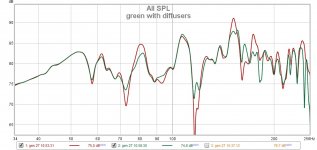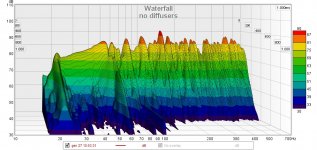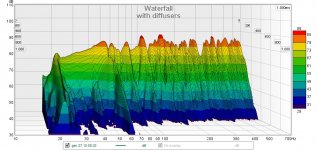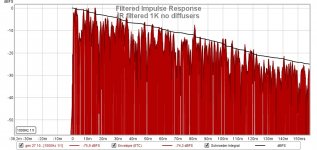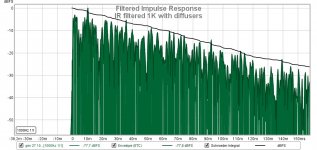Next week.
I will make a measurement and I'll introduce the resonators without moving anything else.
I will make a measurement and I'll introduce the resonators without moving anything else.
Scarrafone effec
Some result.
In measurements without diffusers, a hum appears. A fan? The refrigetor?
Edit: Scarrafone, cockroach. From an italian expression ""Ogne scarrafone è`bello a mamma soia", every cockroach looks beatiful to his mom.
Some result.
In measurements without diffusers, a hum appears. A fan? The refrigetor?
Edit: Scarrafone, cockroach. From an italian expression ""Ogne scarrafone è`bello a mamma soia", every cockroach looks beatiful to his mom.
Attachments
Last edited:
(corrected pipe length) = (2n+1) wavelength /4 n=0, 1, 2, 3, …
for a pipe with circular section (corrected pipe length) = (pipe length) + 0.63radius.
With objects inside, I fear you will have to rehearse.
for a pipe with circular section (corrected pipe length) = (pipe length) + 0.63radius.
With objects inside, I fear you will have to rehearse.
Nice experimentation!
As you have already noticed.........
Indeed!
Right, for max peaking/quickest decay use thin metal tubing or at least PVC pipe like was used [partially seen] to knock down two high Q peaks in Danley's DTS20 sub woofer's response, then damp if desired: http://i240.photobucket.com/albums/ff172/slowcarIX/d1.jpg~original
GM
couldnt old fation deluted woodglue be used as invironmentfriendly treatment instead of titebond or epoxy?
nice experiment Bicicletta!
guys do you have any idea why the very same cavity with a hole (+neck) acts as a resonator in some context (e.g. blowing across the neck of a bottle, enhancing the sound of a guitar body, allowing for the bass reflex effect in a loudspeaker cabinet) and as a selective noise filter in others (e.g. bass traps, acoustic panels, attenuation elements in engine intake systems) even when the cavity is not filled with absorption material?
how come the same element can act in two opposite ways? any clue?
guys do you have any idea why the very same cavity with a hole (+neck) acts as a resonator in some context (e.g. blowing across the neck of a bottle, enhancing the sound of a guitar body, allowing for the bass reflex effect in a loudspeaker cabinet) and as a selective noise filter in others (e.g. bass traps, acoustic panels, attenuation elements in engine intake systems) even when the cavity is not filled with absorption material?
how come the same element can act in two opposite ways? any clue?
- Home
- General Interest
- Room Acoustics & Mods
- Helmholtz for a dummy
